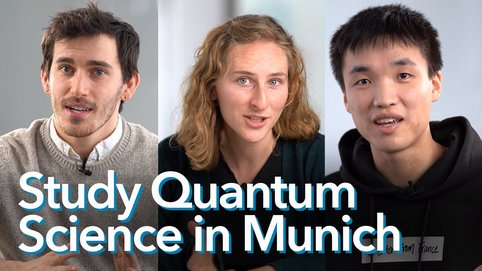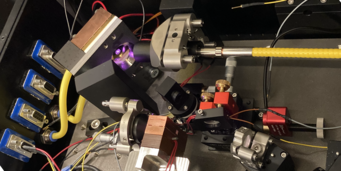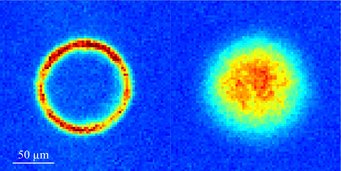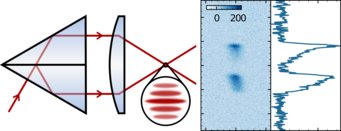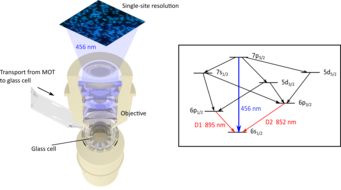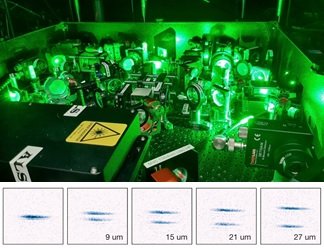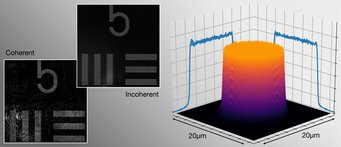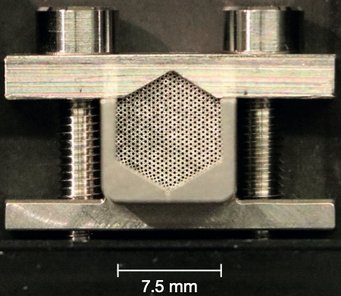Student Positions
We have a variety of smaller and larger projects for students at different levels during their physics education. Reach out to us for more information.
Student interns (HiWi)
In our group, we are constantly looking for student assistants for ongoing projects.
The work includes small electronical projects, building optical (laser) setups, as well as projects relating to measurement and regulation technology.
These tasks offer a great opportunity to get to know our group and our research better. Jobs as a student assistant in our group are popular, and therefore we encourage you to apply early on.
Bachelor projects
Bachelor projects in our group give you a first glimpse into the field of cold-atom research, and allow you to build confidence in working with complex experimental setups and in a research environment. Our projects include e.g., setting up and characterizing lasers, optical setups, mechanical designs or computational tasks. For a Bachelor project in our group, you should have a firm knowledge in optics and quantum mechanics. If you are interested, please contact Prof. Bloch (immanuel.bloch@mpq.mpg.de) to discuss currently available options.
Master projects
You are looking for a challenging project in the field of quantum optics or ultracold quantum gases? Starting with a masters thesis project is a good opportunity to enter the field and learn more about our interdisciplinary research at the interface of quantum optics, quantum information processing and condensed matter physics.
If you are a motivated student with a good background in quantum mechanics (possibly but not necessarily quantum optics), please contact Prof. Bloch (immanuel.bloch@mpq.mpg.de) to discuss currently available projects.
How to Apply for a Master's or PhD Program in Germany
Exemplary past projects in our group
Daniel Adler: Developing a VECSEL setup for the 3P0 tune-out wavelength of 173Yb (Master thesis, 2021)
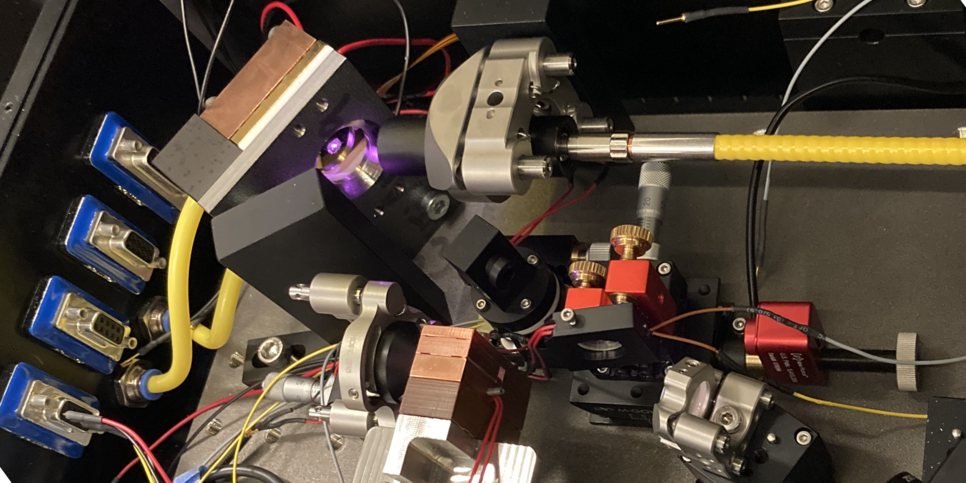
Quantum simulators based on ultracold atoms in optical lattices rely on lasers for nearly every step in the experiment, including cooling, state preparation, the lattices themselves and readout. Depending on their specific task in the experiment, these lasers are required to have, among others, high output powers, narrow linewidths, longterm stability and a large tuning range. The preeminent type of lasers used in such experiments are currently diode lasers, but vertical external cavity surface emitting lasers promise versatile applications due to the wide range of available wavelengths, their circular beam profiles and the achievable high output powers. In the course of this thesis, I built a VECSEL with single-mode operation at the tune-out wavelength of the 3P0 state of 173Yb in the yellow region of the optical spectrum and investigated its suitability for use in experiments with ultracold atoms. To this end, I designed and assembled an optical resonator suitable for intracavity frequency doubling and characterized its performance.
Renhao Tao: Optical box potentials for cold molecules (Master thesis, 2020)
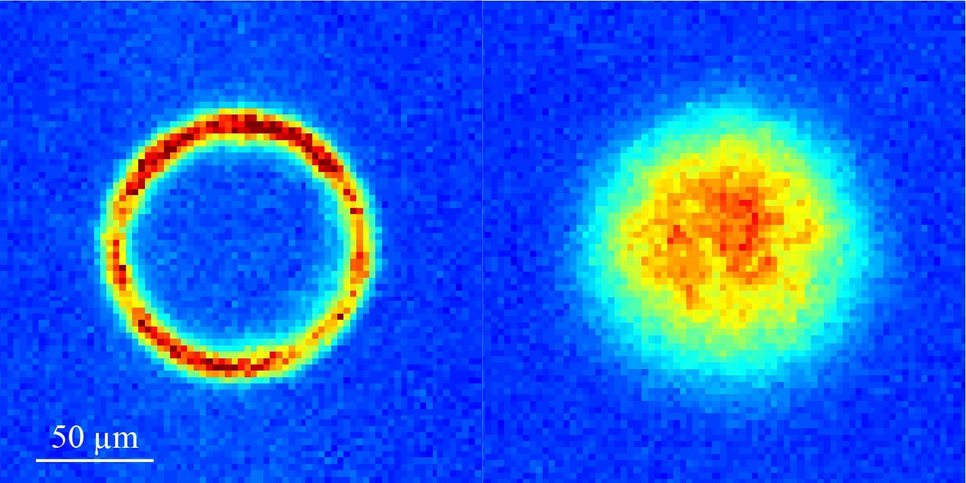
Ultra-cold diatomic molecules is gathering steam lately as one of the leading contenders for simulating quantum many-body system. Their rich internal level structures, coupled with a large anisotropic and long-ranged interaction in case of dipolar molecules, make them particularly appealing in quantum simulation. However, molecules are lossy. Many experiments have confirmed their loss behaviour to be consistent with two-body losses, which is unexpected for non-reactive species. A recent proposal suggests that the trapping light in these experiments, despite being far-detuned from transitions in individual molecules, can electronically excite two-body complexes formed during collisions, which lead to losses. My main project is to use a narrow-linewidth transition to build a blue-detuned box trap to test this hypothesis. In addition, I build a transfer cavity to reference the frequency of the box trap light via a cavity to an atomic transition frequency, a EOM-based wideband intensity noise eater, as well as a shallow-angle lattice for 2D-confinement of molecules.
Alexander Impertro: Preparation and Study of 1D and 2D Many-Body Systems with Fermionic Ytterbium (Master thesis, 2020)
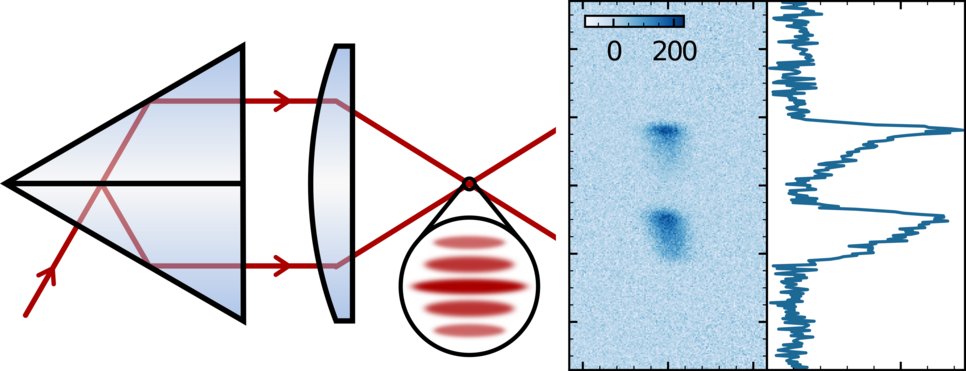
In addition to realizing spatially periodic potentials, optical lattices can be used to strongly confine ultracold atoms in one or more spatial directions. When this confinement is made large enough to freeze out excitations along the lattice direction, the dimensionality of the system can be effectively reduced, leading to intriguing physical behavior. In this project, we built a one-dimensional optical lattice setup specifically tailored to this goal. Using a theoretical model taking into account the thermodynamic properties of our quantum gas, we simulate the lattice spacing necessary to load the atoms into a single plane of the optical lattice. Since the required spacing is on the order of several µm, we create the potential by interfering two laser beams under a shallow angle. At the heart of the experimental setup lies a Kösters prism, which splits a single laser beam into the two lattice beams and promises a high passive phase stability due to its symmetric design. After incorporating the setup into the experiment, we load the atoms into the lattice and implement a protocol to resolve the occupation in the individual planes. Currently, this lattice is being used to prepare and study two-dimensional Mott-insulating states with ytterbium atoms.
Julian Wienand: Multi-level fluorescence imaging and degenerate Raman sideband cooling for a Caesium quantum gas microscope (Master thesis, 2019)
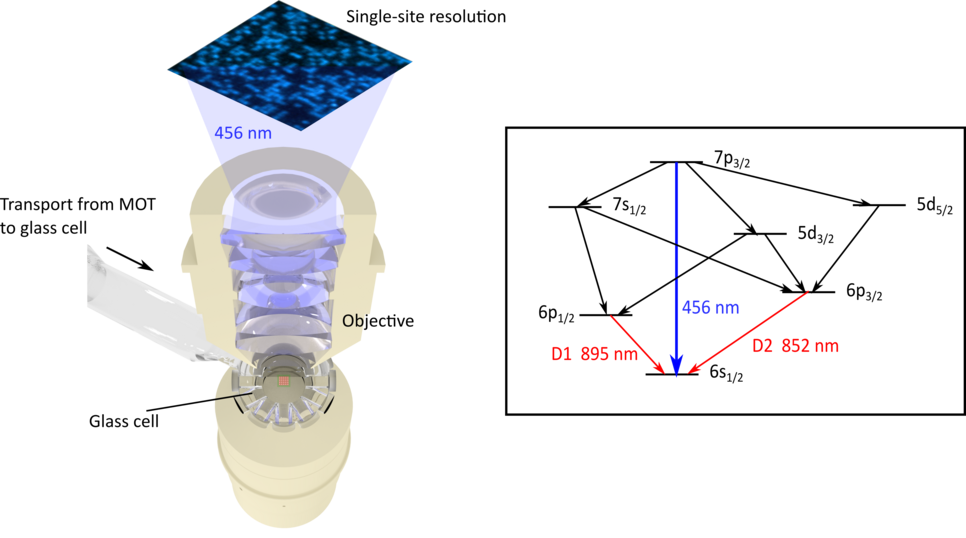
Using transitions at shorter wavelengths is a natural way to further increase the resolution of quantum gas microscopes. However, this comes at the cost of additional heating, in particular, when the transition is not closed. In this project we have investigated to what extent and under which conditions the blue transition at 456 nm is suitable for fluorescence imaging in optical lattices. We have created a three-step model to calculate the number of blue fluorescence photons obtained with sideband-resolved Raman cooling. As a first step toward the experimental realization, a diode laser was frequency-stabilized to the blue transition using frequency modulation spectroscopy. When our new Caesium quantum gas microscope is ready, blue imaging will enable us to study strongly-correlated superlattice-based systems with single-site resolution. As part of its construction, we have implemented degenerate Raman sideband cooling. This stage prepares the atoms for transport to the glass cell which provides large optical access for high-resolution imaging.
Dominik Bourgund: Optical superlattices for ultracold fermionic 6Li (Master thesis, 2019)
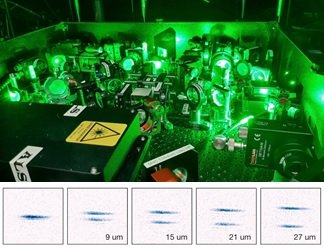
Optical lattices are one of the most prominent tools in the field of ultracold atoms. They allow for a microscopic and highly controllable investigation of models from condensed matter physics. Optical superlattices are created by superimposing two lattices with commensurate lattice constant, which have numerous applications both from a technical as well as physical perspective. However they require a high degree of stability and sophisticated techniques to precisely control the relative phase between the two lattices. One way to solve this issue is to employ a bichromatic superlattice. This was achieved in this project. A high-power source of green light was built via single-pass second harmonic generation. Easy and reliable phase control was achieved by using acousto-optic deflectors to slightly tune the frequency of the laser in combination with a delay line. Finally a highly stable evacuated lattice setup was designed, built and implemented into the experiment. Together this is now being used for vertical spin resolution as well as the preparation of bilayer system in the experiment.
David Wei: Spatially incoherent laser source for potential shaping (Master thesis, 2019)
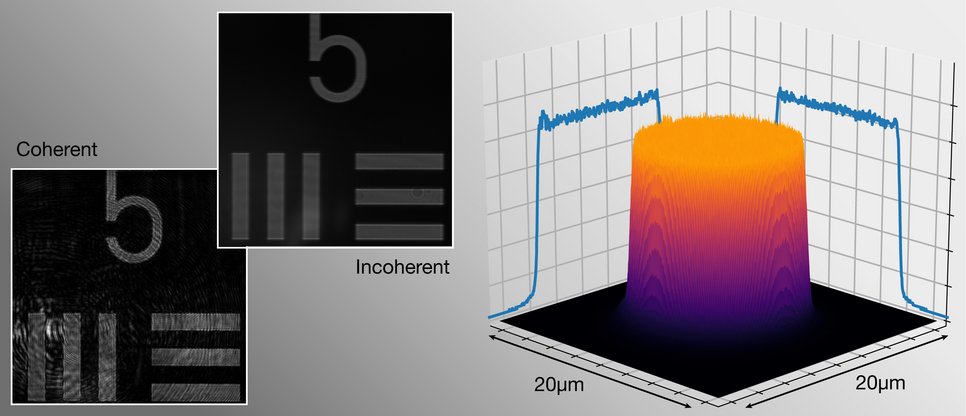
Quantum gas microscopes offer high-resolution observation and control of individual lattice sites in an optical lattice. In combination with off-resonant light projected via a programmable digital micromirror device (DMD), they allow for the generation of arbitrary optical dipole potentials. However, imperfections in the optical path result in so-called speckles, random stationary interference patterns, which significantly deteriorate the potential-shaping quality. One approach to speckle reduction involves using a spatially incoherent light source, for which interferences vanish and noise is additive in intensity instead of field. In this project such a light source was developed. Spatial incoherence is achieved by passing a temporally incoherent (i.e. spectrally broad) source through a square-core multimode optical fibre. The modal dispersion of step-index fibres converts temporal incoherence to spatial incoherence. A femtosecond laser was employed as the broadband light source to provide high-power, low-intensity-noise potentials.
Etienne Staub: A high-flux atomic beam source for strontium quantum gas experiments (Master thesis, 2019)
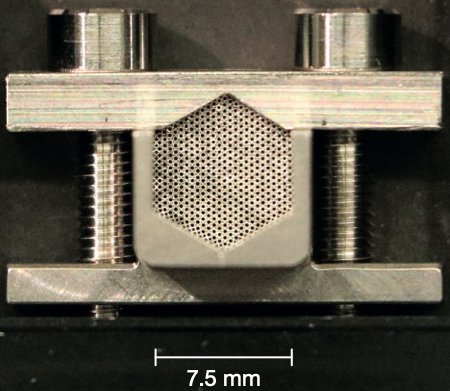
Many experiments working with ultracold atoms suffer from limitations imposed by the duty cycle of their experimental sequence. One way of mitigating this problem is to increase the flux of atoms that can be trapped and cooled. This requires an atomic source with excellent collimation properties and high-temperature capabilities. During this thesis we designed and built such an atomic source for the strontium cavity quantum gas microscope. Our atom source employs a micro-capillary array to collimate the atoms effusing from it and is able to reach high temperatures using two in-vacuum resistive heater circuits. We conducted extensive theoretical modelling of our source and benchmarked its performance with spectroscopic measurements on the atomic beam using a home-built interference filter based external cavity diode laser.
